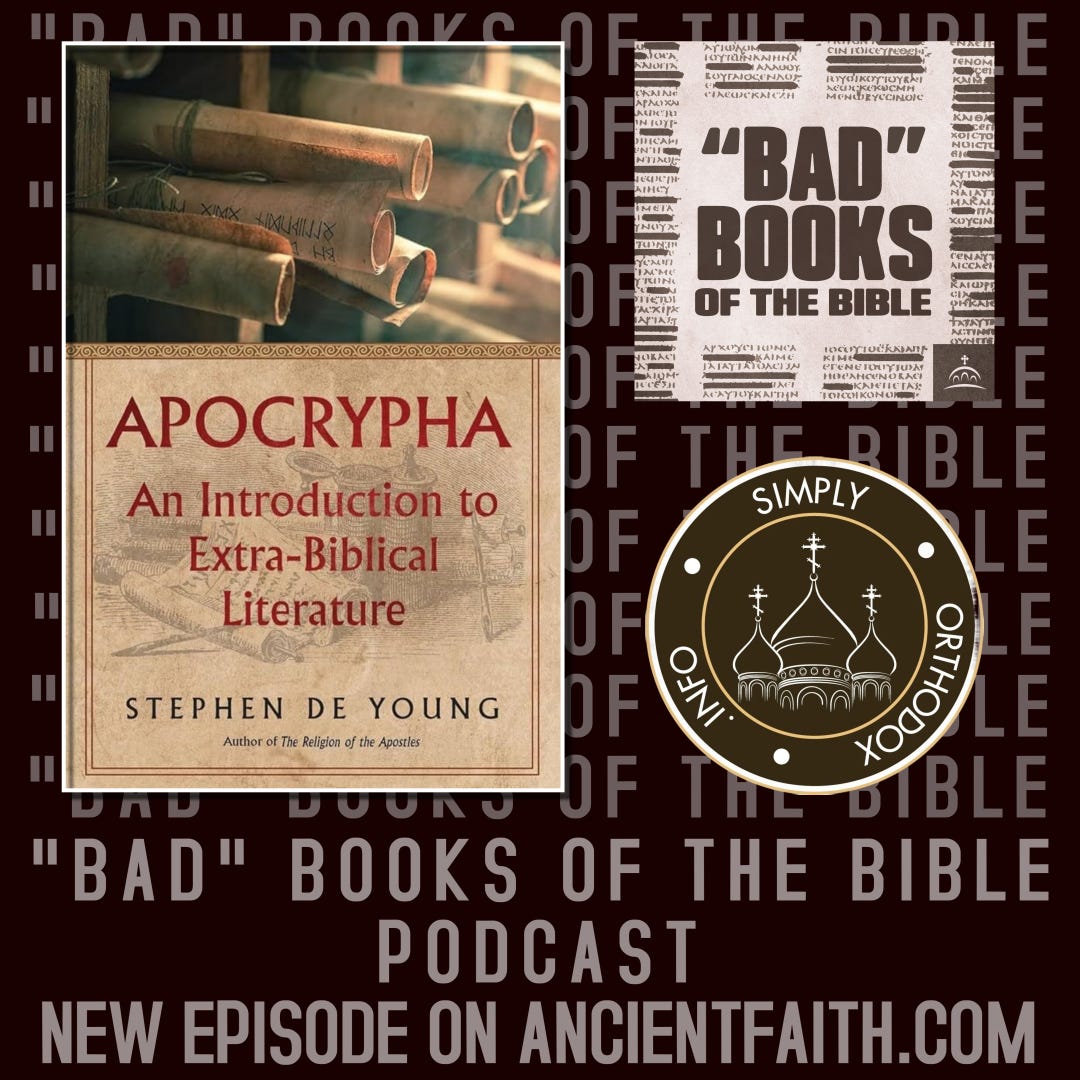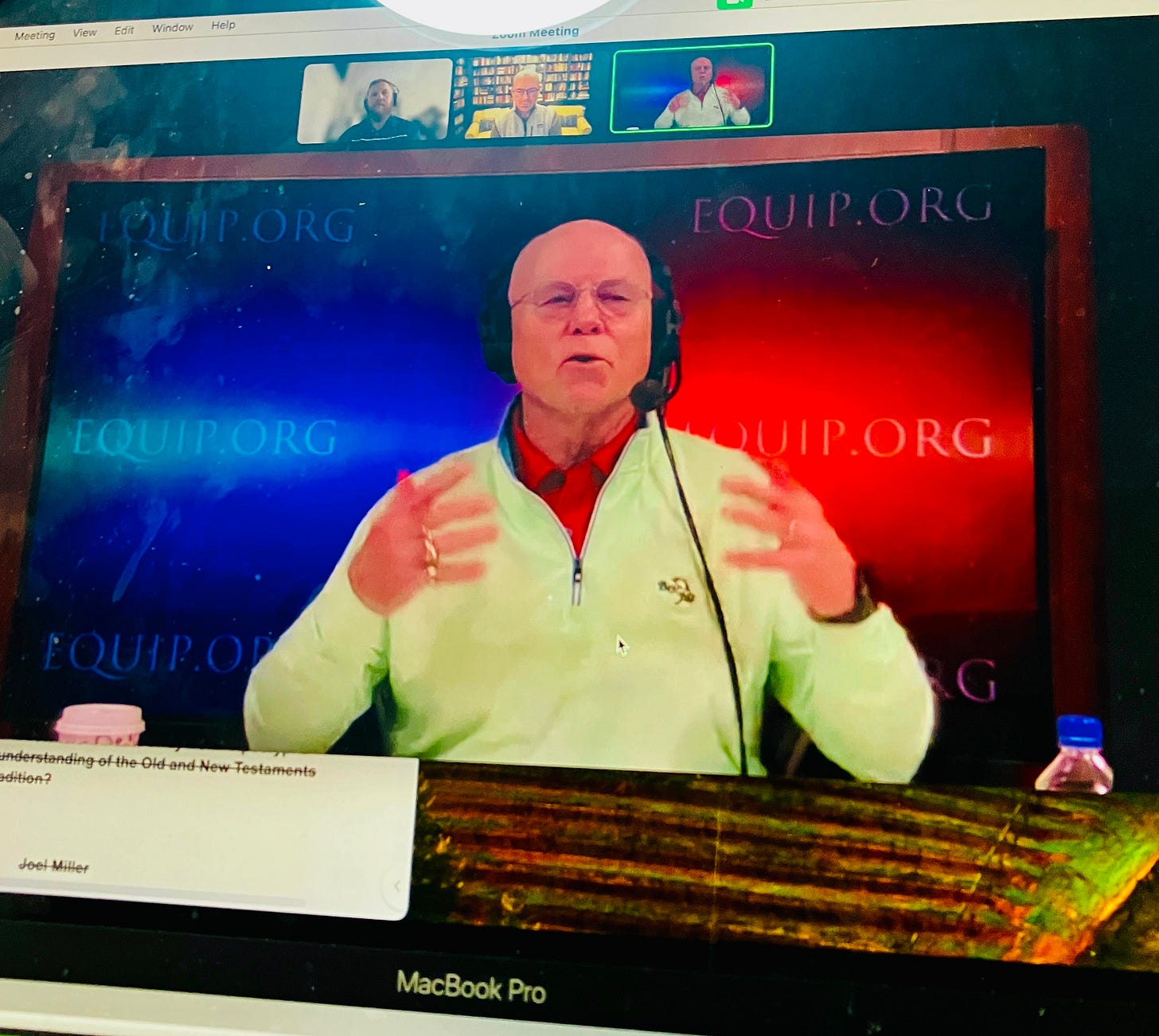The Private Library of the Ancient Church: Fr. Stephen De Young on Apocrypha
A conversation about the "Bad" Books of the Bible beyond the Orthodox canon of Scripture
In the latest episode of “Bad” Books of the Bible on Ancient Faith Radio, co-host Joel Miller and I spoke with Fr. Stephen De Young, pastor of Archangel Gabriel Orthodox Church in Lafayette, Louisiana, and author of Apocrypha: An Introduction to Extra-Biblical Literature (Ancient Faith Ministries, 2023). A scholar with a PhD in Biblical studies, Fr. Stephen is known for his work on early Christian and Second Temple Jewish texts, including The Religion of the Apostles and co-hosting the Lord of Spirits podcast.
This book examines more than forty writings that fall outside the received canon—texts neither publicly proclaimed in the liturgy nor condemned as heretical, but preserved for private study in episcopal and monastic libraries. We had to have him on, because these books are adjacent to the books we cover, and he knows a heck of a lot more about them than we do.
The conversation ranged across the historical, textual, and theological dimensions of these works. In what is below, I’ve tried to summarize our conversation and accurately distill Fr. Stephen’s argument, which is grounded in the ancient Church’s threefold classification of literature.
Three Categories, Not Two
The modern binary—canonical or not—obscures an older taxonomy. As Fr. Stephen explained:
“In the ancient church there were three categories. There were books that were read publicly… in the services in the worship of the church [the canonical category]. There were certainly books listed… as not to be read that were heretical… But then there was this middle category of books to be read privately… books that were good.”
The Greek term apokryphos does not mean “hidden” in the conspiratorial sense popularized by popular streaming documentaries, says Fr. Stephen, but private. These were texts intended for readers with liturgical formation, theological literacy, and access to such restricted collections. Low literacy rates and the prohibitive cost of manuscripts reinforced this restriction.
“Private people didn’t have… libraries in their house,” Fr. Stephen indicated. “Something read publicly, you’re throwing it out there to everyone… Something that’s read privately, you’re restricting it to a group of people who… have a foundation in the church and… a certain level of education.”
And even within the canon, fluidity persisted. For example, the Book of Revelation, now fixed at the end of every printed Bible, was for centuries treated as a private text requiring explanation. “A lot of people put St. John’s Apocalypse in that category still,” Fr. Stephen observed, “not because there was anything bad about the contents… but just that this is a text that requires explanation and… teaching to accompany it.”
Listen on Ancient Faith, or if you prefer:
Summary of Questions Covered in the Episode:
How do you define “apocrypha” in your book, and how is it different from the deuterocanonicals?
How was the concept of private reading shaped by ancient literacy and access to texts?
Why was the Book of Revelation treated cautiously in the early Church?
How did 19th-century Bible printing change Protestant views of the canon?
What role do lectionaries play in understanding textual variants like the woman caught in adultery? (The “pericope adulterae” is the New Testament passage in John 7:53–8:11, which recounts Jesus saving a woman from being stoned for adultery.)
How does St. Nicephorus’s 9th-century list guide your book’s structure?
Why were these texts preserved in Orthodox monasteries but laid aside in rabbinic Judaism?
How should Christians use texts like these? Let’s get into the Testament of the Twelve Patriarchs? How does the Testament of the Twelve Patriarchs illuminate Romans 9–11?
What non-canonical details (e.g., fallen angels, prophecy) enrich our reading of scripture?
How can these texts be used in Orthodox catechesis?
What are three accessible starting texts, and why?
How do we discern truth in apocryphal texts? What about for books like the Gospel of Thomas?
Are Orthodox beliefs about the Theotokos from oral tradition or sourced from texts like the Protoevangelium of James?
What practical spiritual lessons can modern readers draw from these texts?
What is your ultimate hope for readers of Apocrypha?
From Lectionary to Codex: The Neglected Witness
Textual criticism has largely sidelined one of the most significant manuscript traditions: lectionaries. “About 40% of the 6,000 or so manuscripts we have of the New Testament are lectionaries,” Fr. Stephen stated. “None of the data from the lectionaries is in any of the officially published critical editions.”
These liturgical books preserve readings appointed for specific days. When a continuous-text codex was later copied from a lectionary, pericopes were inserted according to the calendar’s sequence—explaining why the story of the woman taken in adultery appears in both John and Luke in different witnesses. The Longer Ending of Mark, similarly, functions as the third resurrectional reading in Codex Sinaiticus.
“A lot of those free-floating texts… are preserved in lectionaries,” Fr. Stephen concluded. “They are… a pretty key witness to the evolution of those final books.”
Preservation as Theological Affirmation
St. Nicephorus, Patriarch of Constantinople in the early ninth century, catalogued the patriarchal library according to the ancient tripartite scheme:
books read publicly in all churches;
books read publicly in some churches;
and books for private reading.
Fr. Stephen structured his volume around this list, appending Nicephorus’s table as a reference inside the text.
Crucially, the texts designated for private or limited public reading are precisely those found in continuous monastic transcription at Mar Saba, St. Catherine’s Monastery, and Mount Athos. “Those very texts are the ones we find preserved at ancient Orthodox monastic settlements,” Fr. Stephen said. “This is… a part… of Orthodox tradition.”
The Testament of the Twelve Patriarchs exemplifies this continuity. A Greek copy from Mount Athos aligns closely with Aramaic fragments from Qumran, demonstrating transmission across centuries and languages. “You could compare a 16th-century copy from Mount Athos in Greek to an Aramaic copy at Qumran and they compare very favorably,” Fr. Stephen pointed out.
Rabbinic Judaism largely abandoned these writings after the Second Temple period; Christianity did not.
Rabbinic Judaism largely abandoned these writings after the Second Temple period; Christianity did not.
Theological Illumination and Catechetical Utility
The Testament of the Twelve Patriarchs is, in Fr. Stephen’s estimation, “the most important book I talk about… for the Old Testament.” Each patriarch’s final charge dramatizes a virtue or vice—Reuben on chastity, Simeon and Levi on wrath, Joseph on forgiveness. These meditations prefigure early monastic treatments of the eight thoughts and offer ready catechetical material.
More strikingly, the text supplies the interpretive matrix for St. Paul’s argument in Romans 9–11. The phrase “fullness of the Gentiles” (Rom. 11:25) echoes Genesis 48:19, where Jacob blesses Ephraim. Readers in the Second Temple period, as reflected in the Testaments of Naphtali and Levi, would have understood the dispersion of the northern tribes as missional “seed” among the nations, to be harvested in the messianic age.
“St. Paul is making [this argument]… He just thinks this is being fulfilled now,” Fr. Stephen explained. “The Messiah’s come and this is actually happening.”
Discernment, Not Infallibility
The Gospel of Thomas appears on Nicephorus’s private-reading list, despite its Gnostic character in the Coptic version. Fr. Stephen proposes that the patriarch knew a less corrupted Greek recension. Church Fathers quote Jesus sayings found only there, suggesting editorial layers. The assumption, he argued, was that “a very educated person who’s grounded in the church… could kind of sift through it… For here’s the wheat, here’s the chaff.”
This posture of critical engagement contrasts with modern tendencies to demand infallibility or reject outright.
“None of the church fathers claimed that their writings were on the level of scripture,” Fr. Stephen reminded listeners. Their hermeneutic—contextual, evaluative, and applied—should inform our reading of both patristic and apocryphal texts.
Oral Tradition and Written Record
Details in the Protoevangelium of James—Joachim and Anna, the Theotokos’s presentation in the temple—raise the question of provenance. Fr. Stephen rejects the notion that the earliest extant text is necessarily the origin:
“It is an unjustifiable assumption to assume that the earliest still-extant text that records any given detail, that detail was invented for that text… The source for the names of the Theotokos’ parents… is reality. They were people who existed and they had names.”
Memory, transmitted orally, eventually found written form. The surviving document is not the source—but the survivor.
Practical Spirituality
The Testament of the Twelve Patriarchs meditates on anger, jealousy, and peacemaking with a sophistication that anticipates New Testament ethics. “Peacemaking is better than victory… reconciliation being better than wrath and anger,” Fr. Stephen summarized.
Fourth Ezra’s vision of the bridegroom recasts God’s love as faithful endurance amid human infidelity, shifting the Christian imagination from fear of wrath to aspiration for fidelity.
Reappropriation in a New Era
Fr. Stephen’s ultimate aim is generational:
“Every generation within the Orthodox Church has to… actively reclaim our heritage… We live in an age now where we can start… reappropriating these things… so that we can have a more robust sense… of the tradition we’ve inherited and… pass it on to the next generation.”
The apocryphal corpus, far from marginal, forms an integral strand of that tradition—preserved, studied, and applied by the Church for two millennia.
Recommended Entry Points
Testament of the Twelve Patriarchs – Essential for Pauline theology and catechesis on virtues/vices.
Joseph and Aseneth – Narrative accessibility; addresses Gentile inclusion and Second Temple diversity.
Acts of Thomas – Historical corroboration (Gundaphar coins, Aramaic churches in India); early Christian encounter with Hinduism.
And obviously, pick up Apocrypha: An Introduction to Extra-Biblical Literature.
Fr. Stephen De Young’s Apocrypha is not a curiosity cabinet but a field guide to a living library—one that continues to speak to the Church’s scriptural, liturgical, and spiritual life.
Coming this Friday, we sit down with Hank Hanegraaff of the Bible Answer Man Broadcast! Make sure you don’t miss it—subscribe here on Substack, or jump over to your podcast platform of choice and smash that follow button!





⛪ Thank you for this 'splainer.
Σοφία Χάρης 🪔 Αγάπη Δόξα
Hello there Jamey, great post, your work appears on my feed a lot, keep it up! I enjoy seeing your name pop up.
I’ve been on substack a month now, and I’m starting to reach out to interesting creators.
I write about history, through historic books (pre-1800), with a philosophical flair.
Here’s one you might enjoy:
https://open.substack.com/pub/jordannuttall/p/a-look-into-the-18th-century?